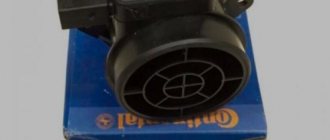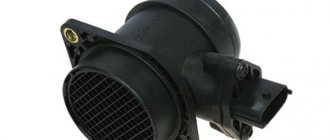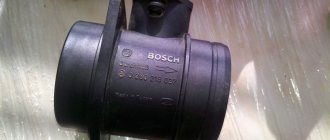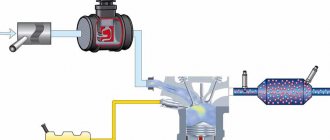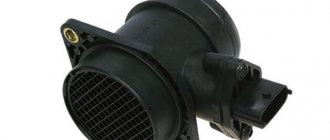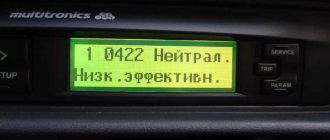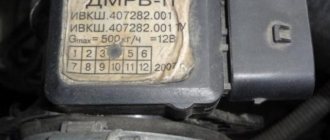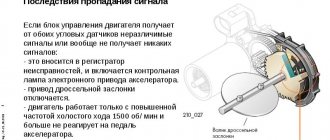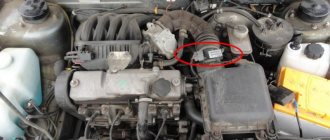Injection (injection) engines on VAZ 2107 vehicles are equipped with a time-tested mass air flow sensor from Siemens.
Of course, there is no German magic here; the sensor can fail, like any other equipment. The car will not stop, the engine will not stall, but the control electronics will switch it into emergency mode. That is, the air entering the intake manifold will not be taken into account by the main “brain”; in this case, the fuel mixture is formed according to the average principle. Gasoline consumption increases, power and torque decrease.
How to check the mass air flow sensor yourself
Symptoms of a malfunctioning mass flow sensor are as follows:
- The “check engine” warning light on the instrument panel is on;
- floating idle speed with a working idle speed controller;
- with a uniform load there is no smooth running of the car;
- starting the engine is difficult (if there are other faults, it is impossible);
- fuel consumption increased unmotivated;
- noticeable loss of power (especially noticeable under load).
The Siemens VDO mass air flow sensor installed on VAZ 2107 vehicles is highly reliable, but it may appear to be faulty due to external influences. For example, contamination, water or oil entering the measuring channel, or power failure. Therefore, checking the VAZ 2107 mass air flow sensor for the injector engine begins with inspecting the sensor. It needs to be removed.
- disconnect the negative terminal from the battery;
- release the fastening clamp and separate the intake manifold pipe from the flange of the mass air flow sensor;
- carefully disconnect the power and control connectors (the temperature of the plastic clips becomes brittle);
- unscrew the fasteners and remove the sensor from the air filter housing.
We inspect the internal cavity and sensors. Conductors and fasteners of elements should not have any visual damage, there should be no dust, moisture or oil stains on the surface.
The case should also not have damage, cracks, or through abrasions.
Important: When separating the injection mass air flow sensor from the intake manifold pipe, check the integrity of the rubber pipe. Unaccounted for air leakage bypassing the flow meter can also indicate symptoms of a sensor malfunction.
Of course, existing contaminants must be removed. The cavities of the measuring channel are purged with compressed air.
Important: Wiping with a rag or brush is not allowed; there is a risk of damaging the measuring elements.
You can use special sprays (not carb cleaner or WD-40!) to clean flow meters. After cleaning, it is necessary to eliminate the cause of the dirt. Most often, debris gets into the mass air flow sensor from an untimely replaced air filter.
Purifier selection options
How to clean the flow meter? The modern market offers many products for cleaning regulators; let’s look at the most effective options:
- Liqui Moly. This manufacturer, as you know, produces not only cleaning products, but also motor and transmission oils, as well as other types of liquids. If you believe the official information provided by the manufacturer, then this product belongs to the high-quality category. Accordingly, the cost of such a MAF cleaner will also be high. In fact, Liqui Moly cleaners cope with their tasks quite effectively - this product perfectly removes dirt from the sensor. If the flow meter was in working order at the time of cleaning, then after that it will work for a long time. The use of Liqui Moly is relevant in both gasoline engines and diesel power units.
- Alternatively, you can use alcohol to clean the device. This method is considered one of the oldest, but nevertheless the most effective. Due to its chemical properties, alcohol is good at removing clogs that accumulate on the sensitive component of the air flow sensor. Despite its effectiveness, today this method is not used so often and is usually used by unscrupulous technicians at service stations. The client pays for a special substance, for example, Liqui Moly, and in fact the cleaning is carried out using alcohol.
- The next option is fluid for carburetor engines. This option is considered one of the most effective and frequently used. Using carburetor fluid, you can effectively clean it, and as practice shows, such a product allows you to remove all contaminants.
- Another product sold in spray form is Liquid Key. This cleaner is used to remove all kinds of contaminants, not only from the flow meter, but also from other mechanisms and components.
- A universal tool for performing many tasks is WD-40. This liquid is used by our compatriots to clean all kinds of components, remove rust, get rid of squeaks, etc. Not so long ago, our car enthusiasts began to use it to clean flow meters (the author of the video is the Gen channel MB W140 Germany).
Checking the electrical part with a multimeter
To find out what condition the electrical circuit of the mass air flow sensor is in, you will need to pinout the Siemens VDO contacts. First we check the block on the ECU side. We fix the negative wire of the multimeter to ground and turn on the ignition. We connect the positive wire to contact No. 5 of the block: normal supply voltage is 12 V. Similarly, we check contact No. 4; normal voltage is 5 V. If the values are different, check the ECU or the wiring harness from the mass air flow sensor to the engine control unit.
Important: The reason for the loss of supply voltage may be simple corrosion of the contacts; the operating conditions of the sensor are far from ideal.
How to check the sensor for the correct output signal? Using a diagnostic scanner (ideal) or the same multimeter. The output contact readings show not only the serviceability of the mass air flow sensor, but also the remaining resource.
It is necessary to connect the positive wire to the signal contact of the connector (on the VAZ 2107 this is green No. 3), and the negative wire to ground. The multimeter is set to a measurement range of up to 2 V, the error is up to hundredths of a voltmeter.
After turning on the ignition, the device should display a value of about 1 volt.
- readings from 0.9 V to 1.02 V – the DMF works perfectly;
- from 1.03 V to 1.05 V – service life is coming to an end;
- more than 1.05 V, or absent altogether - the sensor must be replaced.
Note: Repairing the mass air flow sensor is not practical due to the low cost of the device itself and the complexity of the design.
In the design of sevens with injection-type engines, a mass air flow sensor is installed. The abbreviation stands for mass air flow sensor, which has a direct impact on the quality of engine operation. If the mass air flow sensor on a VAZ 2107 begins to malfunction, the engine will still work, but it is not recommended to operate it for such a long time. If this element breaks down, it should be replaced immediately.
Mass air flow sensor on VAZ 2107
The injection engine is controlled by electronics that receive information from various sensors, adjusting the supply of the fuel-air mixture and ignition. The mass air flow sensor shows the volume of air supplied to the combustion chamber. Against the background of data received by the ECU, the dosage of gasoline is calculated, forming the optimal amount of the fuel-air mixture.
DMRV VAZ 2107 injector is located between the throttle valve and the air filter element (it is mounted in the pipe). The device in question is based on two electrical conductive threads. The principle of operation is based on temperature fluctuations of the first and second threads. To do this, one thread is located directly so that it is blown by the air sucked into the system, and the second is hidden from the influence of the air flow on it.
When air enters the system, the first thread cools, and at the same time the current resistance in the circuit decreases. The more air enters, the stronger the cooling process. The second thread is the control thread, and its resistance does not change. The difference in resistance between the first and second threads is recorded by the ECU, on the basis of which a decision is made on the need to enrich or lean the fuel mixture. If it breaks, the engine will continue to operate, but only in a mode in which the fuel mixture will be mixed in the wrong proportions.
Symptoms of malfunction
The malfunction of this sensor on the VAZ 2107 is indicated by the inclusion of the Check Engine control indicator. However, the absence of an indication does not always indicate the serviceability of the part in question. This is due to the fact that the part very rarely fails completely. Often its malfunction is manifested through incorrect readings. With such readings, the ECU receives a signal from the device, and accordingly makes an appropriate decision on the need to enrich or lean the mixture.
If there is a suspicion that the device in question is malfunctioning, then you need to pay attention to the following symptoms:
- An increase in fuel consumption is detected.
- The idle speed increases, and unstable engine operation is observed at idle.
- The car becomes less pliable by reducing power and dynamics.
- Problems with starting the engine when hot.
The MAF sensor is one of the most expensive spare parts, and if it breaks, it needs to be replaced. It cannot be repaired, but before replacing it, you need to make sure that the sensor is really faulty. If you suspect a device malfunction, you should first check the integrity of the air duct. After all, often the cause of DMRV errors is the intake of air from outside, bypassing the sensor.
Sensor failure may be minor when the surface of the platinum filament becomes dirty. In this case, it can be cleaned. First, let's figure out how to check the device for serviceability.
Checking the mass flow sensor with your own hands
The serviceability of the device in question can be determined with high accuracy only in a car service center that has specialized equipment. However, not every car service center has a special stand, and even if it does, it’s not good to go for diagnostics every time with the above-mentioned symptoms in order to find out the cause. Instructions on how to check the sensor at home include the following steps:
On a VAZ 2107 injector, it is recommended to install a Siemens-branded air flow sensor made in Germany. MAF pinout for Siemens:
- +12V.
- +5V from the ECU.
- Signal.
- DTV.
- Weight.
Removal and installation of the seven mass air flow sensor
If the part in question is faulty, it should be replaced. Replacing the air flow sensor on a VAZ 2107 is carried out according to the following instructions:
- The clamp that secures the air duct is loosened.
- After this, you need to remove the air duct pipe and unscrew the bolts securing the sensor to the filter.
- Disconnect the power supply from the device and remove the element from the car.
- A new sensor is installed, and finally it remains to tighten the clamp securing the air exhaust hose.
When the old mass air flow sensor is dismantled, you can clean it. Before cleaning the sensor, it must be disassembled. Platinum thread is cleaned with alcohol. The block connector must also be inspected for oxidation. Fixing a breakdown of the mass air flow sensor on the seven can be resolved quickly if it is clearly established that the cause is a faulty sensor.
The VAZ 2107 has been produced for a very long time and during this time has remained virtually unchanged, with the exception of the engine. Initially, the seventh Lada model rolled off the assembly line with an engine with carburetor fuel injection, but time passed and AvtoVAZ needed to modify the car and adjust it to EURO standards. Therefore, the carburetor engine was replaced by an injector.
As you know, injection engines have a large number of different sensors that are involved in the operation of the internal combustion engine. Failure of at least one of the sensors can lead to a malfunction of the engine and a change in its characteristics.
In this article we will talk about the mass air flow sensor on the VAZ 2107, namely its purpose, signs of malfunction, design, cost, methods of self-checking and replacement.
Interchangeability
This issue is quite relevant, especially taking into account the cost of original products from the imported automobile industry. But it’s not so simple here, let’s give an example
In the first production models of the Gorky Automobile Plant, the injection Volgas were equipped with a BOSCH air flow sensor. Somewhat later, imported sensors and controllers replaced domestic products.
A – imported filament air flow sensor manufactured by Bosh (pbt-gf30) and its domestic analogues B – JSCB “Impuls” and C – APZ
Structurally, these products were practically no different with the exception of several design features, namely:
- The diameter of the wire used in a wirewound thermistor. Bosch products have a diameter of 0.07 mm, and domestic products have a diameter of 0.10 mm.
- The method of fastening the wire differs in the type of welding. For imported sensors this is resistance welding, for domestic products it is laser welding.
- Shape of a thread thermistor. Bosh has a U-shaped geometry, APZ produces devices with a V-shaped thread, and products from JSC Impulse are distinguished by the square shape of the thread suspension.
All the sensors given as an example were interchangeable until the Gorky Automobile Plant switched to film analogues. The reasons for the transition were described above.
Film air flow sensor Siemens for GAZ 31105
It makes no sense to give a domestic analogue to the sensor shown in the figure, since outwardly it is practically no different.
It should be noted that when switching from filament devices to film devices, most likely, it will be necessary to change the entire system, namely: the sensor itself, the connecting wire from it to the ECU, and, in fact, the controller itself. In some cases, the control can be adapted (reflashed) to work with another sensor. This problem is due to the fact that most filament flowmeters send analog signals, while film flowmeters send digital signals.
It should be noted that the first production VAZ cars with an injection engine were equipped with a filament air flow sensor (made by GM) with a digital output; examples include models 2107, 2109, 2110, etc. Now they are equipped with a BOSCH 0 280 218 004 mass air flow sensor.
To select analogues, you can use information from official sources or thematic forums. As an example, below is a table of the interchangeability of mass air flow sensors for VAZ cars.
Compatibility table for mass air flow sensor for the VAZ model range
The presented table clearly shows that, for example, the MAF sensor 0-280-218-116 is compatible with VAZ 21124 and 21214 engines, but is not suitable for 2114, 2112 (including those with 16 valves). Accordingly, you can find information on other VAZ models (for example, Lada Granta, Kalina, Priora, 21099, 2115, Chevrolet Niva, etc.).
As a rule, there will be no problems with other brands of cars of domestic or joint production (UAZ Patriot ZMZ 409, Daewoo Lanos or Nexia), choosing a replacement mass air flow sensor for them will not be a problem, the same applies to products of the Chinese automobile industry (KIA Ceed, Spectra, Sportage etc.). But in this case, there is a high probability that the MAF pinout may not match; a soldering iron will help correct the situation.
The situation is much more complicated with European, American and Japanese cars. Therefore, if you have a Toyota, Volkswagen Passat, Subaru, Mercedes, Ford Focus, Nissan Premiere P12, Renault Megane or another European, American or Japanese car, before replacing the mass air flow sensor, you need to carefully weigh all the solution options.
If you are interested, you can search online for an epic about an attempt to replace the “native” air meter with an analogue on a Nissan Almera H16. One attempt resulted in excessive fuel consumption even at idle.
Read more: Treatment of thresholds with bitumen mastic
In some cases, searching for an analogue one will be justified, especially if you take into account the cost of the “native” VU meter (for example, the BMW E160 or Nissan X-Trail T30)
DMRV VAZ 2107
This sensor is installed on the VAZ 2107 by the German company Siemens. This brand is well known in the market and makes fairly high-quality parts, so the mass air flow sensor of this company works for a very long time and reliably.
The sensor is installed on the air filter housing and an inlet corrugation is attached to it, through which air passes and enters the engine.
Purpose and design
The purpose of the mass air flow sensor is to count the air that enters the engine to mix with fuel to form the fuel mixture. In order for fuel and air to be mixed in the required proportions, it is necessary to determine how much air enters the engine at a certain point in time - this is the main task of the mass air flow sensor.
Structurally, the sensor has a cylindrical shape inside, which contains a special sensitive element, which determines the volume of air passed through the sensor. On top of the mass air flow sensor there is a connector to which the power and control circuit is connected; this circuit is connected to the electronic engine control unit.
How to clean the sensor
All dirt collects on the sensitive element of the device, made of platinum, so special attention must be paid to the cleaning composition. Can not use:
- liquids that include ether, ketone or acetone;
- compositions used to clean carburetors;
- cotton wool wrapped around a toothpick or match and compressed air.
What then should you use? The best option is WD40. A “liquid key” sold as a spray is also suitable. Another option for rinsing is a special liquid from Liqui Moly: however, the cost of the product is around $12.
Symptoms of a problem
Signs of a malfunction of the mass air flow sensor may be similar to the breakdown of other sensors; computer diagnostics using ADC channels will help to more correctly identify a faulty mass air flow sensor.
Signs of a faulty mass air flow sensor:
- Increased fuel consumption;
- Unstable operation of the internal combustion engine in all modes;
- Difficulty starting the engine;
- Loss of power and dynamics;
If your car has such breakdowns, then most likely you need to check the mass air flow sensor.
Checking the mass air flow sensor
Checking the air flow sensor can be divided into 4 stages: shutdown, using a multimeter, visual and computer.
Disconnection test
This test is the simplest and most accessible, but does not provide 100% information about the performance of the sensor.
So, to check you need to disconnect the connector from the sensor and start the car. Then you need to drive the car and evaluate its dynamic performance. If the car begins to accelerate better and operate more stably, then it is most likely that the mass air flow sensor is still faulty.
Checking with a multimeter
This test is more complex, but every owner of a VAZ 2107 can do it. To carry out diagnostics using this method, you must have a regular household multimeter that is capable of measuring DC voltage.
- We set the multimeter switch to measure DC voltage.
- We connect one multimeter probe to ground, and the second to the terminal on the mass flow sensor connector numbered “5” (the wire block is numbered). The voltage between these two points when the ignition is on should be 12V.
- Next, we move the probe to pin “4”; the voltage at this pin should be 5V.
If the readings differ, the sensor is faulty or the battery is discharged.
Visual inspection
The condition of the sensor can be assessed visually after its dismantling. When the sensor is removed, it is necessary to evaluate its internal parts, they should be intact without traces of dirt, dust and oil. In some cases, simply cleaning the sensitive element helps bring the sensor back to life.
Testing with the device
This check can be carried out using a special diagnostic tool via ADC channels. This method will give 100% results.
Replacement of BOSCH DMRV with Siemens from classics. — Lada 2110, 1.5 l., 1998 on DRIVE2
Once I was unlucky with replacing this ill-fated sensor. I wanted to buy a new Bosch 116 or 037, which is cheaper, it wouldn’t take long to transfer calibrations. But some articles on installing a Siemens MAF on a front-wheel drive VAZ haunted me. Its price is noticeably lower, but its durability, on the contrary, is higher; there is even an article about it on the chiptuner. If you install Siemens from the Volga, you need to adjust the mount to the air filter, but from the classics it fits one to one. You just need to solder a new connector to the sensor and connect the wires differently. Well, of course, it is necessary to replace the calibration in the firmware. So I decided to buy a Siemens DMRV. I hope this time it’s not a fake) There’s even a passport in the box.
After installing the sensor
Full size
the wires are temporary) please do not throw stones, I will put them in a corrugation)
I decided to start the car without flashing the brain) the result is predictable - it stalls immediately after starting. I grab the brain in my hand and run home to sew.
After installing the edited firmware, the car started up with half a turn, picks up speed perfectly, and the response to the gas pedal is also immediate. Consumption on a warm engine at idle is 0.7-0.8 liters. Once there was a RAM error,
Full size
error, I don’t know what it’s connected with, disappeared as suddenly as it appeared
disappeared after the next restart. The car now pleases with acceleration and the absence of twitching and stupidity, and this is on the stock firmware)) I’ll upload the dynamic one soon)
Useful videos
download photo to your mobile phone Contents: - maintenance and repair manual for the VAZ 2107 car
Section 11: - description of the engine control system of the VAZ 2107
To perform the work of checking the mass air flow sensor (MAF) of the VAZ 2107, you will need a multimeter.
The sequence of work to check the mass air flow sensor (MAF) of the VAZ 2107 1. We prepare the VAZ 2107 car for operations (see “Preparation of the VAZ 2107 car for maintenance and repair”). 2. Pressing the latches, disconnect the wiring harness block from the mass air flow sensor. 3. We connect the “negative” voltage probe of the engine of the VAZ 2107 car. 4. Having turned on the ignition on the VAZ 2107 car, use a voltmeter to measure the supply voltage at terminal “5” of the wiring harness block. The voltage at the terminal block of the mass air flow sensor should be
Removing the mass air flow sensor (MAF) from a VAZ 2107 car 1. Using a Phillips screwdriver or an 8 mm wrench, loosen the clamp securing the air exhaust hose from the mass flow sensor housing and remove the hose from the mass air flow sensor branch pipe.
2. Using a 10 mm wrench, unscrew the two bolts securing the mass air flow sensor to the air filter housing and remove the air flow sensor. 3. Remove the O-ring from the mass air flow sensor (MAF). You can verify that the mass air flow sensor is faulty by replacing it with a known good sensor.
Installing a mass air flow sensor (MAF) on a VAZ 2107 car Installation of the sensor is carried out with a mass air flow (MAF) sensor on a VAZ 2107 car in the reverse order.
Replacement
Replacing the sensor is quite simple; even an untrained person can cope with the task. To do this, you just need to prepare a 10mm open-end wrench and a Phillips screwdriver.
- Remove the negative terminal from the battery;
- Remove the connector from the sensor;
- Unscrew the two bolts securing the sensor to the air filter housing;
- Using a screwdriver, unscrew the corrugation clamp from the sensor;
- Install the new sensor in reverse order;
Lada 2110 ツɐʞdиҺツ (EX) › Logbook › Checking the mass air flow sensor with your own hands VAZ.
The mass air flow sensor (MAF) is located near the air filter to determine the amount of air flow passing through the air filter. Malfunctions of the mass air flow sensor negatively affect engine performance. Don’t rush to replace it with a new one, try checking the mass air flow sensor first.
Other symptoms of a malfunctioning mass air flow sensor: 1) Check Engine error appears; 2) Increased fuel consumption; 3) Poor starting when hot; 4) The car began to accelerate slowly; 5) Engine power lost. 6) Etc.
How to check the mass air flow sensor
Method number 1: Disable the mass air flow sensor.
Disconnect the sensor connector and start the engine. If you turn off the MVR, the controller switches to emergency mode and prepares the fuel mixture only according to the throttle position. Engine speed must be greater than 1500 rpm. Let's try to go for a ride. If the car feels “faster”, then we can say that the mass air flow sensor is not working. By the way, for ECU Y7.2, M7.9.7. The speed does not increase when the chip is turned off!
Method No. 2: Alternative ECU firmware.
If the standard firmware of the controller was replaced with another, then it is unknown what is built into it in case of emergency mode in method No. 1. Try sliding a 1mm thick plate under the damper stop. The revs will rise. Pull out the chip from the mass air flow sensor. If it doesn’t stall, it means the problem is with the firmware, or rather with the IAC steps in emergency mode without a mass air flow sensor.
Method No. 3: Checking the mass air flow sensor with a multimeter.
This method works on Bosch sensors with catalog numbers: 0 280 218 004, 0 280 218 037, 0 280 218 116. Turn on the tester in the DC voltage measurement mode, set the measurement limit to 2 Volts.
MAF pinout: 1) Yellow (closest to the windshield) - MAF signal input; 2)Gray-white—sensor supply voltage output; 3) Green - sensor grounding output; 4) Pink-black - to the main relay. Wire colors may change, but the pin layout remains the same. Wire colors may change, but the pin layout remains the same.
We turn on the ignition, but do not start the engine. We connect the multimeter with the red probe to the yellow mass flow sensor, and the black one to the green one (to ground). Thus, we measure the voltage between the specified terminals. The tester probes allow you to penetrate through the rubber seals of the connector, along the specified wires, without disturbing their insulation.
The use of needles and other additional connections is not recommended, because they introduce some error into measurements. We take readings from the multimeter. The output voltage of the new sensor is 0.996…1.01 Volts. During operation, it gradually changes and, as a rule, increases. The greater the value of this voltage, the greater the wear of the mass air flow sensor.
Mass air flow sensor voltage: 1.01…1.02 - good condition of the sensor. 1.02...1.03 - not a bad condition. 1.03…1.04 - the life of the mass air flow sensor is coming to an end. 1.04...1.05 - a dying state, if there are no negative symptoms, then we continue to exploit it. 1.05...and higher - it’s time to replace the mass air flow sensor.
By the way, the same readings can be obtained without a tester, using the on-board computer (group of parameters “voltage from sensors”, Udmrv)
Like 28 Subscribe
Site about off-road vehicles, SUVs, off-road vehicles
The mass air flow sensor (MAF) on the ZMZ-409 engine is located between the air filter hose and the intake pipe hose and is designed to convert the air flow entering the engine into DC voltage. Information from the mass air flow sensor allows the control unit to determine the engine operating mode and calculate the cyclic filling of the cylinders with air at steady-state engine operating modes, the duration of which exceeds 0.1 seconds.
Operating principle, general structure and analogues of the UAZ mass air flow sensor with the ZMZ-409 engine.
Depending on the configuration and type of electronic control unit, ZMZ-409 engines can be equipped with mass air flow sensors with a sensitive element made in the form of a conductive film applied to a ceramic base, or in the form of a platinum thread. The sensor signal is a DC voltage whose value depends on the amount and direction of air flowing through the sensor.
The sensor's sensitive element is built on the principle of a thermistor anemometer. It is heated by electric current and its operating temperature is maintained constant. If the air flow through the sensor increases, the sensitive element begins to cool, and the mass air flow sensor control circuit increases its heating current until its temperature is restored to its original level.
Thus, the magnitude of the heating current of the sensitive element is proportional to the air flow. At the same time, the secondary converter of the mass air flow sensor converts the heating current of the element into a DC output voltage.
Structurally, the air flow sensor consists of a plastic body made in the form of a pipe at the ends of which protective grilles are installed. The housing contains a sensitive element, and in the upper part of the sensor there is a secondary converter board closed with a sealed plastic case, and a connector plug, which, depending on the type of sensor, has a different shape and number of pins.
Together with the Mikas 7.2 control unit, mass air flow sensors Bosch HFM5-4.7 0 280 218 037, Siemens HFM62C/11 or NPP AVTEL 20.3855 with a film sensitive element could be installed. With Mikas 11 block - Siemens HFM62C/19 with film or 20.3855-10 with thread sensitive element. With block ME17.9.7 - Bosch HFM7-4.7 0 280 218 220.
External manifestations of a malfunction of the UAZ mass air flow sensor with a ZMZ-409 engine.
A malfunction of the mass air flow sensor on a running ZMZ-409 engine is characterized by an increase in fuel consumption, a significant deterioration in dynamics during acceleration and problems with starting the engine. If a malfunction occurs in the sensor connection circuits or the sensor itself, the on-board self-diagnosis system lights up the Check Engine warning light, which is constantly on when the engine is running, and issues fault codes.
Mikas 7.2
013 - low signal level of the mass air flow sensor (MAF).
What is a mass air flow sensor
During operation, the engine consumes not only expensive fuel, but also free air. Moreover, according to the laws of the physical and chemical process of fuel ignition in the combustion chamber, the engine needs about 12-14 liters of air to burn a liter of fuel. Only then will the combustion efficiency be maximum, only then will there be no excess fuel consumption and then the amount of toxic emissions will be minimal. It's easier with fuel. The amount of fuel the injector supplied to the cylinder was the amount of fuel burned. How much gasoline was bought, the pump pumped into the fuel frame. Air is currently released to one person in unlimited quantities; if we talk about the process of fuel combustion, then oxygen must be strictly controlled. This is why they install a mass air flow sensor, a mass air flow sensor.
The air flow sensor measures the exact amount of air entering the cylinder and transmits this information to the electronic engine control unit. The ECU, in turn, based on these data draws conclusions about how much fuel needs to be supplied. The mass air flow sensor, of course, is not the last resort that affects the fuel supply, but its readings in this matter are very important.
The principle of operation of the mass air flow sensor
To determine the engine load and the amount of mixture that is needed to operate the engine in this mode, the ECU carries out calculations every second to create the correct mixture proportion. By pressing the accelerator pedal, we open the air damper, which allows a certain amount of air to pass through, and the exact amount is determined by the sensor.
The sensor itself is located in front of the throttle valve, and it consists of a platinum-coated conductor about 70 microns thick. In general, there are two types of sensors:
The mechanical sensor simply determines the volume of air based on the position of the throttle valve. Currently, such sensors are not used in internal combustion engines. The thermal method of measuring air flow takes into account the heating of the platinum element. Sensors are usually installed between the filter and the throttle in the intake tract.
DF (Phase Sensor) or CPRV (Camshaft Position Sensor)
Determines the angular position of the camshaft. For eight-valve engines, it is fixed at the end of the block head. On a sixteen-valve engine there is about 1 cylinder on the block head.
Until about 2005, it was not installed on 8-valve engines, which means that fuel injection into the intake manifold will be carried out in pairs-parallel mode. That is, two injectors open at once.
The power units in which it is installed are characterized by phased injection, that is, only one injector nozzle opens into which fuel should be injected.
FAULTS: If it fails, the car automatically switches to pairwise-parallel mode, which leads to excess fuel consumption of 10-15%.
Costs about 250 – 400 rubles
As you can see, there are about eight main sensors in the system; once again I would like to remind you that in some modern units there can be much more of them. These same ones are found in any simple motor that is installed on hundreds of simple machines.
I’ll end here, sincerely yours AUTOBLOGGER
214,62
Similar news
Is it possible to put diesel oil into a gasoline engine? Which .
Boring the cylinder block. Why does the engine need it and can it be done?
How many valves are there in the engine? Let's look at rare cases
Source
Malfunctions of mass air flow sensor in diesel engines and injection engines
Since the adjustment of mixture formation is based on the readings of the mass air flow sensor, its failure can significantly affect the operation of the engine as a whole. Sometimes symptoms of a malfunction of the mass air flow sensor can be expressed in complete engine failure, seemingly for no apparent reason. There are, however, less alarming, but more eloquent symptoms that the sensor is not working correctly or has failed altogether.
- the engine warning light may come on;
- increase in fuel consumption, not stable, but periodic;
- a decrease in dynamics and loss of power may be observed;
- difficult start-up even under normal conditions;
- unstable idle speed.
Since thermal sensors are also installed in diesel engines, the symptoms may be identical. Exclusively diesel symptoms include characteristic black smoke from the exhaust pipe, but this cannot guarantee an accurate diagnosis. The symptoms are familiar to those who have encountered completely different problems in the operation of the motor, so they alone cannot judge the condition of the sensor. If there are suspicions about the correctness of its readings, the sensor must be checked.
Definition of failure
Symptoms of a malfunction of the mass air flow sensor are quite typical and varied, considering that it is responsible for the formation of the fuel mixture. Key Features:
- gasoline consumption has increased unreasonably;
- The “Check engine” indicator came on;
- Engine power has dropped noticeably;
- the speed gain dynamics have changed;
- in idle mode the speed began to “float”;
- it has become impossible or very difficult to start the engine.
Many of the reasons listed may indicate malfunctions of other parts or components. Therefore, you need to make sure that the problems that arise are actually a problem in the sensor.
How to check the mass air flow sensor
Since we no longer use mechanical sensors, but only use thermoelectric ones, we will measure the electrical parameters of the sensor to check it. Although the most childish way to check the sensor is to simply remove the block from the mass air flow sensor connector at idle speed. As soon as the block is turned off, the ECU loses sight of the sensor and gives a signal about emergency operation, while in the meantime it is guided by the readings of the damper angle sensor. At this moment, you can find out whether the mass air flow sensor is working or not. After disconnecting the pads, the engine may begin to operate intermittently and the idle will float. On a warm engine, you can drive for several kilometers with the sensor turned off. If traction appears and power visually increases, the sensor is unsuitable for use.
The test can also be carried out by measuring the signal on the far right wire. If the sensor is working, the voltage on the leg will be within 1-1.5 V. If the readings are higher, the sensor is faulty and must be replaced or washed. In this way, in simple ways, you can first determine the malfunction of the mass air flow sensor without diagnostic equipment. Do not dirty the sensor, and good luck to everyone!
Let's understand what the mass air flow sensor (MAF) of the injection VAZ-2107 is
In carburetor "Sevens" the best ratio of gasoline and air oxygen is ensured by the diameter of the carburetor jets and diffusers, and very often this ratio is not ideal. The VAZ-2107 injection engine runs on an air-fuel mixture, the component parts of which are calculated by the processor of the electronic control unit (abbreviated ECU). For its normal operation, you need to obtain information on several parameters, one of which is the amount of air oxygen sucked into the combustion chambers of the engine cylinders. The air flow sensor of the VAZ-2107 is mounted in the air filter pipe and is connected by a pipe to the boss of the throttle body. It monitors the amount of air passing by monitoring the temperature difference between two thin conductive strands of platinum. The first is mounted so that it is blown by air passing through the mass air flow sensor housing, and the second, comparative (control), is hidden from the airflow. The more air is blown through the sensor, the more the first thread cools and the more its resistance drops compared to the second thread. This resistance difference, in the form of an output signal, goes to the VAZ-2107 ECU, and it, taking into account the temperature of the control thread, calculates how much gasoline needs to be supplied. If no data is received from the mass air flow sensor, the engine will not stall. But it will not work at all as expected. Even worse, when the signals go wrong, this often happens because the contacts are dirty. The ECU gets confused, gives incorrect instructions to the injectors and, as a result, the engine runs intermittently.
What does the VAZ-2107 injector say about a non-working mass air flow sensor
Always, if there are problems with this sensor, the “Check engine” lamp lights up. If there is an on-board computer, it will issue the corresponding error code. The engine, if there is a malfunction of the mass air flow sensor, runs, but: – gasoline consumption increases; – idle speed “floats”; – the car accelerates sluggishly and pulls poorly; – it is difficult to start the engine, especially when it is hot. All this is very similar to the “manifestations of diseases” of other systems of the injection VAZ-2107, for example, a speed sensor or idle air control. And yet, with these “symptoms”, you need to check the mass air flow sensor first. Of course, the easiest way is to replace it with a new one, but the price is steep. Before replacement, you need to check the tightness of the connector, whether the connecting pipe from the sensor to the throttle body is intact, and whether the platinum thread is dirty. All this leads to errors in the operation of the sensor.
You can check the VAZ mass air flow sensor like this:
The fastest and most accurate method is to connect a motor tester. Unfortunately, such a device is quite expensive, and using it correctly is also not so easy. Near the house or in “garage” conditions, you can use the following methods: A. Disconnect the connector from the mass air flow sensor, start the engine and drive a few kilometers. The car's ECU begins to work “bypassing” the sensor readings, determining the required parameters based on the readings of other, working sensors. If you feel improvements in the engine’s performance, the mass air flow sensor is faulty.
B. You can “ring” the VAZ-2107 mass air flow sensor with a multimeter. We turn on the device for voltage measurement mode up to 20 volts; when the ignition is on, the voltage at pin “5” should be 12 volts. On pin “4” the reading is at least 5 volts. If this is not the case, you need to check the power supply circuits of the air flow sensor and the ECU itself, and if the voltage is normal, the sensor is faulty.
DMRV connector contact numbers
B. Remove the sensor and inspect it carefully. Everything inside must be clean; oil deposits, debris, and dust are not allowed. The mesh at the entrance should also be clean. Check the housing for cracks, dents, and warping. All seals must be intact, preventing air leaks. Inspect the nozzles and landing places of the mass air flow sensor; any leakage is unacceptable here.
Changing the MPV sensor VAZ-2107 injector
You will need 8 mm, 10 mm wrenches and a screwdriver. – loosen the clamp of the outlet pipe; – remove the outlet pipe from the mass air flow sensor; – use a 10 mm wrench to unscrew the two bolts securing the filter; – remove the mass air flow sensor from the car; – carefully remove the rubber ring from the broken sensor and place it on the new one; – we mount the new mass air flow sensor in place, fasten it with bolts; – put on the pipe and secure it with a clamp; – connect the connector in place.
We start the engine and enjoy the operation of a working VAZ-2107 mass air flow sensor. You can see what's inside the sensor
Comments and reviews
At idle it stalls and jerks when driving
Hello! VAZ 2115, 1.6 l, injection mileage 40 t.km. a year ago, when starting from 1500 rpm, it doesn’t troit, after 5 minutes it troits. I restarted it, it doesn’t troit. In the urban cycle, it’s normal. On the highway 90-110, when I release the gas, it troits. Restarts and normal acceleration is sharp. Thank you.
Hello. I have the same problem, fuel consumption has increased from 8 to almost 12, when starting the engine when cold, the speed reaches normal, then immediately drops to 500, then it rises to normal until the car warms up, and when warm, the speed in drive drops to 550 -600 in reverse gear the same, the speed of my car is 800-990
Hello, yesterday the check engine light came on. Connected elm327. I use the open diag program. Error code P0172 (rich mixture). Doesn't start well. The revolutions are floating. Sometimes it just stalls. Is it the DMRV? Or maybe something else?
